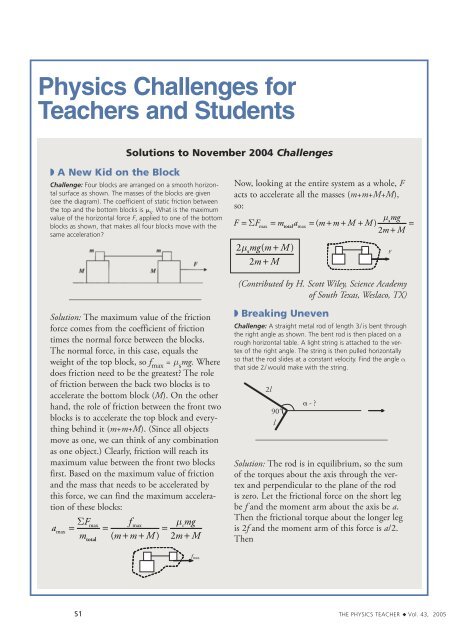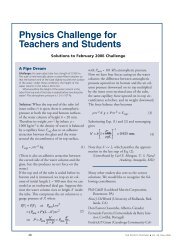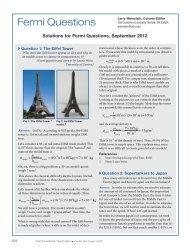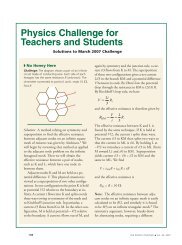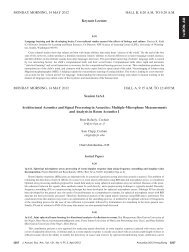Physics Challenges for Teachers and Students - Scitation
Physics Challenges for Teachers and Students - Scitation
Physics Challenges for Teachers and Students - Scitation
You also want an ePaper? Increase the reach of your titles
YUMPU automatically turns print PDFs into web optimized ePapers that Google loves.
<strong>Physics</strong> <strong>Challenges</strong> <strong>for</strong><br />
<strong>Teachers</strong> <strong>and</strong> <strong>Students</strong><br />
◗ A New Kid on the Block<br />
Solutions to November 2004 <strong>Challenges</strong><br />
Challenge: Four blocks are arranged on a smooth horizontal<br />
surface as shown. The masses of the blocks are given<br />
(see the diagram). The coefficient of static friction between<br />
the top <strong>and</strong> the bottom blocks is s . What is the maximum<br />
value of the horizontal <strong>for</strong>ce F, applied to one of the bottom<br />
blocks as shown, that makes all four blocks move with the<br />
same acceleration?<br />
Solution: The maximum value of the friction<br />
<strong>for</strong>ce comes from the coefficient of friction<br />
times the normal <strong>for</strong>ce between the blocks.<br />
The normal <strong>for</strong>ce, in this case, equals the<br />
weight of the top block, so fmax = µ smg. Where<br />
does friction need to be the greatest? The role<br />
of friction between the back two blocks is to<br />
accelerate the bottom block (M). On the other<br />
h<strong>and</strong>, the role of friction between the front two<br />
blocks is to accelerate the top block <strong>and</strong> everything<br />
behind it (m+m+M). (Since all objects<br />
move as one, we can think of any combination<br />
as one object.) Clearly, friction will reach its<br />
maximum value between the front two blocks<br />
first. Based on the maximum value of friction<br />
<strong>and</strong> the mass that needs to be accelerated by<br />
this <strong>for</strong>ce, we can find the maximum acceleration<br />
of these blocks:<br />
ΣFmax<br />
f max µ smg<br />
amax<br />
= =<br />
=<br />
m ( m + m + M ) 2m<br />
+ M<br />
total<br />
f max<br />
Now, looking at the entire system as a whole, F<br />
acts to accelerate all the masses (m+m+M+M),<br />
so:<br />
µ smg<br />
2µ<br />
F = ΣFmax = mtotalamax = ( m + m + M + M ) =<br />
2m<br />
+ M<br />
2µ<br />
smg( m + M )<br />
2m<br />
+ M<br />
(Contributed by H. Scott Wiley, Science Academy<br />
of South Texas, Weslaco, TX)<br />
◗ Breaking Uneven<br />
Challenge: A straight metal rod of length 3l is bent through<br />
the right angle as shown. The bent rod is then placed on a<br />
rough horizontal table. A light string is attached to the vertex<br />
of the right angle. The string is then pulled horizontally<br />
so that the rod slides at a constant velocity. Find the angle α<br />
that side 2l would make with the string.<br />
Solution: The rod is in equilibrium, so the sum<br />
of the torques about the axis through the vertex<br />
<strong>and</strong> perpendicular to the plane of the rod<br />
is zero. Let the frictional <strong>for</strong>ce on the short leg<br />
be f <strong>and</strong> the moment arm about the axis be a.<br />
Then the frictional torque about the longer leg<br />
is 2f <strong>and</strong> the moment arm of this <strong>for</strong>ce is a/2.<br />
Then<br />
S1 THE PHYSICS TEACHER ◆ Vol. 43, 2005<br />
2l<br />
90˚<br />
l<br />
- ?<br />
F<br />
mg( m + M )<br />
2m<br />
+ M<br />
s
sinθ = θ<br />
a 2<br />
a<br />
<strong>and</strong> cos =<br />
l<br />
l 2<br />
where θ <strong>and</strong> α are supplementary angles.<br />
Consequently,<br />
tanθ = so<br />
1<br />
4<br />
α = 108o –tan-1 0.25 = 166o .<br />
(Contributed by Eugene P. Mosca, U.S. Naval<br />
Academy, Annapolis, MD)<br />
◗ A Vicious Semicircle<br />
Challenge: A block of mass M can slide without friction<br />
along a horizontal table. A simple pendulum of mass m <strong>and</strong><br />
length l is mounted on the block so that it can swing freely<br />
in the vertical plane. The pendulum is released from the<br />
horizontal position as shown. Find the maximum tension of<br />
the string during the subsequent motion of the pendulum.<br />
Assume that the string is light <strong>and</strong> that the pendulum bob<br />
is very small.<br />
M<br />
Solution: Let the counterclockwise angle that<br />
the string makes with the vertical be θ, so that<br />
the bob starts out at +90, swings around to<br />
–90 where every part of the system again<br />
comes instantaneously to rest, then oscillates<br />
back <strong>and</strong> <strong>for</strong>th in this manner ad infinitum.<br />
It turns out, as I shall prove below, that the<br />
maximum tension occurs at 0 when the string<br />
is vertical. I shall find an expression <strong>for</strong> the tension<br />
at any angle <strong>and</strong> then maximize it.<br />
I will consider the fourth quarter of a period<br />
of oscillation, in which the bob is traveling up-<br />
m<br />
ward to the right with decreasing speed υ relative<br />
to the mount, <strong>and</strong> the block in reaction is traveling<br />
to the left with speed V <strong>and</strong> slowing down so<br />
that its acceleration A is to the right. Consider<br />
the free-body diagram <strong>for</strong> the bob <strong>and</strong> the base<br />
with mounting pole.<br />
V<br />
M<br />
l<br />
T<br />
V<br />
ac v<br />
at mg<br />
The two <strong>for</strong>ces on the bob are the tension T<br />
<strong>and</strong> the weight mg. The acceleration of the bob<br />
relative to the ground is the vector sum of the<br />
acceleration A of the mount plus the acceleration<br />
a of the bob relative to the mount. I have decomposed<br />
a into two components: the centripetal<br />
acceleration a c = υ 2 /l <strong>and</strong> the tangential acceleration<br />
a t , whose directions at the present instant<br />
are as drawn. Newton’s second law <strong>for</strong> the bob in<br />
the radial direction is<br />
2<br />
υ<br />
T − mg cosθ = m −mA<br />
sin θ,<br />
(1)<br />
l<br />
while <strong>for</strong> the base in the horizontal direction we<br />
have<br />
T sin θ = MA . (2)<br />
Solve Eq. (2) <strong>for</strong> A <strong>and</strong> substitute that into<br />
Eq. (1) to get<br />
2<br />
⎛ m 2 ⎞<br />
υ<br />
T ⎜1+<br />
mg m . (3)<br />
⎝⎜<br />
sin θ<br />
M ⎠⎟<br />
= cosθ<br />
+<br />
l<br />
Next we use the conservation laws to find the<br />
speed υ, noting that the bob’s velocity relative<br />
to the ground is the vector sum of υ <strong>and</strong> V.<br />
Suppose the zero level of gravitational potential<br />
energy is chosen to lie at the initial position of<br />
the bob, so that the total energy E of the system<br />
THE PHYSICS TEACHER ◆ Vol. 43, 2005 S2<br />
T<br />
A<br />
A
is zero. This must also equal the sum of the<br />
kinetic <strong>and</strong> potential energies of the system at<br />
the current instant,<br />
1<br />
2 2 1 2<br />
m ⎡(<br />
υ cos θ− V ) + ( υ sin θ) ⎤ MV mgl cosθ<br />
0<br />
2 ⎣⎢<br />
⎦⎥ + − =<br />
2<br />
(4)<br />
Meanwhile, conservation of linear momentum<br />
in the horizontal direction implies that<br />
m(υ cos θ – V ) = MV . (5)<br />
Solve Eq. (5) <strong>for</strong> V <strong>and</strong> substitute that into<br />
Eq. (4) to prove that<br />
2<br />
υ<br />
M + m<br />
m = 2mg<br />
cosθ<br />
. (6)<br />
l<br />
2<br />
M + m sin θ<br />
Substituting Eq. (6) into (3) leads to the<br />
desired expression <strong>for</strong> T as a function of θ,<br />
m<br />
3<br />
3cos θ + ( 3cos<br />
θ −cos<br />
θ)<br />
T<br />
M<br />
(7)<br />
=<br />
mg<br />
2 .<br />
m 2 ( 1+<br />
sin θ<br />
M )<br />
To maximize this, we should make the numerator<br />
as big as possible <strong>and</strong> the denominator as<br />
small as possible. Both requirements are satisfied<br />
when θ is 0. There<strong>for</strong>e,<br />
Tmax<br />
m<br />
= 3+ 2 . (8)<br />
mg M<br />
It is interesting to explore the limiting cases<br />
of this expression. If M / m → ∞ then Tmax =<br />
3mg, which is the tension at the bottom of the<br />
swing (corresponding to a centripetal acceleration<br />
of 2g) of a pendulum bob traveling in a<br />
semicircular arc at the end of a mount fixed<br />
to the Earth (acting as a really massive block).<br />
On the other h<strong>and</strong>, consider what happens if<br />
M / m → 0. Since there are no external horizontal<br />
<strong>for</strong>ces on the system, the center of mass<br />
cannot move sideways. If M = 0 this means<br />
the bob does not move horizontally relative to<br />
the Earth, but simply free-falls straight down,<br />
<strong>and</strong> the massless mounting block slides over<br />
in exactly the right manner to always keep the<br />
string just barely taut. The tension in the string<br />
is zero (since there cannot be a net horizontal<br />
<strong>for</strong>ce exerted on a massless block) until the<br />
angle reaches zero, at which point the tension<br />
suddenly (but smoothly) diverges to provide<br />
the impulse needed to reverse the bob’s vertical<br />
motion.<br />
(Contributed by Carl E. Mungan, U.S. Naval<br />
Academy, Annapolis, MD)<br />
Column Editor's Note: If one does assume<br />
a priori that the maximum tension corresponds<br />
to the moment when the bob passes through<br />
the lowest point, the solution path may be different,<br />
<strong>for</strong> example, this solution:<br />
The maximum tension occurs when the string<br />
is vertical. In that position (which I call “final”<br />
position), both the tension T of the string <strong>and</strong><br />
the weight mg of the mass m are vertical, so (according<br />
to Newton’s second law)<br />
T – mg = ma my ,<br />
where amy is the vertical acceleration of the<br />
mass m at that instant. This acceleration can be<br />
written as amy = vrel<br />
l<br />
2 (centripetal acceleration),<br />
where vrel is the velocity of the mass m relative<br />
to the pivot. Then,<br />
2<br />
vrel<br />
T = m( g + ).<br />
l<br />
Let us calculate vrel using energy conservation.<br />
The energy of the system at the initial position<br />
is Ei = mgl (I put the zero level of the gravitational<br />
potential energy at the final position).<br />
The total energy at the final position is<br />
1 2 1 2<br />
E mv Mv Then,<br />
f = m + M .<br />
2 2<br />
1 2 1 2<br />
mvm + MvM = mgl.<br />
2 2<br />
Note that, at the final position, both masses m<br />
S3 THE PHYSICS TEACHER ◆ Vol. 43 2005
<strong>and</strong> M are moving, because the resultant <strong>for</strong>ce<br />
on the system (m+M) is zero (linear momentum<br />
conservation). For this reason,<br />
m<br />
m<br />
mv Mv v v v<br />
M M v<br />
2<br />
2<br />
2<br />
m + M = 0 ⇒ M = − m ⇒ M = 2 m.<br />
Then,<br />
1 1<br />
1<br />
2 2<br />
2 1<br />
2<br />
2<br />
2 2<br />
mv M 2<br />
2 2<br />
1<br />
m<br />
m<br />
v mgl<br />
M M v<br />
m + m = ⇒ ( + ) m =<br />
gl<br />
gl ⇒ vm<br />
= .<br />
m<br />
+<br />
M<br />
Now as<br />
m <br />
v v v v<br />
,<br />
M v<br />
m<br />
M v<br />
rel = m − M = m + m = ( + ) m 1<br />
we have<br />
v<br />
m<br />
M v<br />
m<br />
M<br />
gl<br />
2<br />
2 2<br />
v m<br />
= ( 1+ ) m = ( 1+ )( 2 ) ⇒ = 2g ( 1+<br />
).<br />
l M<br />
2 rel<br />
rel<br />
Putting this in the expression <strong>for</strong> T, we obtain<br />
T m g g g m<br />
M<br />
mg<br />
m<br />
= ( + 2 + 2 ) = ( 3 + 2 ).<br />
M<br />
The maximum tension of the string is<br />
m<br />
mg(<br />
3+ 2 ).<br />
M<br />
Note that if M >> m, T <br />
3mg, the “st<strong>and</strong>ard” result (<strong>for</strong> fixed mass M).<br />
If, instead, M = m, T = 5mg.<br />
(Contributed by Fern<strong>and</strong>o Ferreira, Universidade<br />
da Beira Interior, Covilhã, Portugal)<br />
Several other readers also sent us correct solutions<br />
to the November <strong>Challenges</strong>. We would<br />
like to recognize the following contributors:<br />
Michael C. Faleski (Delta College, Midl<strong>and</strong>, MI)<br />
John F. Goehl Jr. (Barry University, Miami Shores,<br />
FL)<br />
Art Hovey (Mil<strong>for</strong>d, CT)<br />
Mark Lenfestey (Homestead HS, Wayne, IN)<br />
Adam Plana (The Wheatley School, Old Westbury,<br />
NY)<br />
Bayani I. Ramirez (San Jacinto College South,<br />
Houston, TX)<br />
Ben Stam <strong>and</strong> Tim Thomas, students (Oklahoma<br />
School of Science <strong>and</strong> Mathematics Regional<br />
Center, Enid, OK)<br />
Leo H. van den Raadt (Heemstede, The Netherl<strong>and</strong>s)<br />
We appreciate your submissions <strong>and</strong> hope to<br />
receive more solutions in the future.<br />
Note to contributors:<br />
For the duration of the WYP contest, the submission<br />
guidelines have been slightly changed.<br />
Please read carefully—especially if you are a<br />
regular contributor.<br />
– only email submissions will be considered;<br />
– email your solutions to Boris Korsunsky at<br />
korsunbo@post.harvard.edu;<br />
– please email the solutions as Word files;<br />
– please email each solution as a separate file;<br />
– note that each problem, in addition to a<br />
very clever title, has a code such as F1. Please<br />
name each file as “problem code-first initiallast<br />
name.” For instance, “F1DVader” if your<br />
name is Darth Vader <strong>and</strong> you are sending the<br />
solution to problem F1;<br />
– please state your name, hometown, <strong>and</strong> professional<br />
affiliation in each file.<br />
We look <strong>for</strong>ward to your (<strong>and</strong> your students’)<br />
participation.<br />
Please send correspondence to:<br />
Boris Korsunsky<br />
korsunbo@post.harvard.edu<br />
THE PHYSICS TEACHER ◆ Vol. 43, 2005 S4


